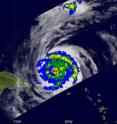Hurricane warnings posted on US East Coast, NASA sees Earl's heavy rainfall
NASA's Tropical Rainfall Measuring Mission, or TRMM satellite looked at the rate rain was falling in Hurricane Earl yesterday, and it was intense. The TRMM satellite passed close to Hurricane Earl's position early on August 31 at 0439 UTC (12:39 a.m. EDT) collecting data used in the TRMM Microwave Imager (TMI) rainfall analysis. At that time, TRMM observed a band of rain drenching Puerto Rico as it spiraled into the powerful hurricane. At the time Earl had become a powerful category four hurricane with wind speeds of about 115 knots (~132 mph). Very heavy rainfall of over 50 mm/hr (2 inches) clearly defined the location of Earl's eye wall. TRMM is managed by NASA and the Japanese Space Agency.
Another NASA satellite analyzed Hurricane Earl's cloud temperatures and thunderstorms. High, cold thunderstorm cloud tops indicate powerful storms. NASA's Atmospheric Infrared Sounder (AIRS) instrument flies aboard the Aqua satellite and captured an infrared image of Hurricane Earl today, Sept. 1 at 06:53 UTC (2:53 a.m. EDT). It showed high, powerful thunderstorms circle the center providing the heat engine for the hurricane. Earl's eye was not visible in the image, possibly because it was going through eyewall replacement, which usually occurs in major hurricanes.
On September 1 at 1500 UTC (11 a.m. EDT), Earl was a Category 3 hurricane with maximum sustained winds near 125 mph. Earl's center was located about 725 miles south-southeast of Cape Hatteras, N.C. near 25.1 North and 72.1 West. It is moving to the northwest near 17 mph, and had a minimum central pressure of 943 millibars.
Earl is a large storm, with tropical storm-force winds extending out from the center to 200 miles, and hurricane-force-winds extending out 90 miles from the center. The extent of hurricane-force winds has increased since yesterday.
A Hurricane warning is in effect from Bogue Inlet,N.C. to the N.C./V.A. border, including Pamlico and Albemarle Sounds. That means that hurricane conditions expected within 36 hours. A Hurricane watch has been posted from the North Carolina/Virginia border to Cape Henlopen, Delaware. That means Hurricane conditions expected within 48 hours. Tropical storm warning is in effect from Cape Fear, N.C. to west of Bogue Inlet, N.C. and San Salvador Island, Central Bahamas. That means Tropical storm conditions expected within 36 hours.
What can be expected? A storm surge of 3 to 5 feet above normal tidal levels expected in the warning area, with large and destructive waves. Large swells should affect the Bahamas and southeastern U.S. today. In terms of rainfall, the Bahamas and extreme eastern North Carolina, including Outer Banks, can expect 1 to 2 inches, locally up to 4 inches of rain.
Earl is expected to maintain intensity for the next few days, as it moves northwest, then north.
Source: NASA/Goddard Space Flight Center
Articles on the same topic
- NASA satellite and International Space Station catch Earl weakeningFri, 3 Sep 2010, 19:50:23 UTC
- GOES-13 satellite sees Hurricane Earl's clouds covering the US NortheastFri, 3 Sep 2010, 14:17:19 UTC
- NASA hurricane researchers eye Earl's eyeFri, 3 Sep 2010, 14:17:16 UTC
- NASA catches heavy rainfall happening in Category 4 Earl as it approaches the USThu, 2 Sep 2010, 20:38:21 UTC
Other sources
- CIMAS, NOAA research conduct innovative investigations to study Hurricane Earlfrom PhysorgTue, 7 Sep 2010, 19:56:12 UTC
- Hurricanes Throw Birds Off Coursefrom Live ScienceTue, 7 Sep 2010, 16:56:15 UTC
- Hurricanes like Earl throw birds off coursefrom MSNBC: ScienceTue, 7 Sep 2010, 15:49:14 UTC
- Hurricane's Path Unfamiliar to U.S. Northeastfrom CBSNews - ScienceMon, 6 Sep 2010, 16:28:43 UTC
- Video: Diminished Earl Still A Threatfrom CBSNews - ScienceMon, 6 Sep 2010, 16:28:28 UTC
- How Are Hurricanes Named?from Live ScienceSun, 5 Sep 2010, 14:42:11 UTC
- As a Hurricane, Earl Looked Like 'Magnificent Chaos' From Spacefrom Space.comSat, 4 Sep 2010, 13:28:09 UTC
- Video: Diminished Earl Still A Threatfrom CBSNews - ScienceSat, 4 Sep 2010, 9:49:13 UTC
- Video: Diminished Earl Still A Threatfrom CBSNews - ScienceSat, 4 Sep 2010, 9:21:46 UTC
- Video: Diminished Earl Still A Threatfrom CBSNews - ScienceFri, 3 Sep 2010, 23:56:17 UTC
- Video: Diminished Earl Still A Threatfrom CBSNews - ScienceFri, 3 Sep 2010, 23:35:17 UTC
- Weaker Hurricane Earl heads for New Englandfrom LA Times - ScienceFri, 3 Sep 2010, 22:28:13 UTC
- NASA satellite and International Space Station catch Earl weakeningfrom PhysorgFri, 3 Sep 2010, 21:49:05 UTC
- Why Hurricane Earl Weakened on Path to Cape Codfrom National GeographicFri, 3 Sep 2010, 21:42:12 UTC
- NASA satellite and International Space Station catch Earl weakeningfrom Science BlogFri, 3 Sep 2010, 20:14:13 UTC
- NASA hurricane researchers eye Earl’s eyefrom Science BlogFri, 3 Sep 2010, 15:21:19 UTC
- GOES-13 satellite sees Hurricane Earl’s clouds covering the US Northeastfrom Science BlogFri, 3 Sep 2010, 15:21:18 UTC
- GOES-13 satellite sees Hurricane Earl's clouds covering the US Northeastfrom PhysorgFri, 3 Sep 2010, 14:42:13 UTC
- NASA hurricane researchers eye Earl's eyefrom PhysorgFri, 3 Sep 2010, 14:21:11 UTC
- Hurricane's Path Unfamiliar to U.S. Northeastfrom CBSNews - ScienceFri, 3 Sep 2010, 12:21:14 UTC
- Hurricane's Path Unfamiliar to U.S. Northeastfrom CBSNews - ScienceFri, 3 Sep 2010, 10:28:08 UTC
- Earl takes swipe at North Carolina, heads northfrom LA Times - ScienceFri, 3 Sep 2010, 3:42:11 UTC
- Hurricane's Path Unfamiliar to U.S. Northeastfrom CBSNews - ScienceFri, 3 Sep 2010, 2:14:22 UTC
- NASA Hurricane Researchers Eye Earl's Eyefrom NASA Jet Propulsion LaboratoryFri, 3 Sep 2010, 1:56:19 UTC
- Hurricane's Path Unfamiliar to U.S. Northeastfrom CBSNews - ScienceFri, 3 Sep 2010, 1:28:11 UTC
- Earl's path along northeast is not well-wornfrom PhysorgThu, 2 Sep 2010, 22:07:23 UTC
- Earl's path along northeast is not well-wornfrom AP ScienceThu, 2 Sep 2010, 22:07:18 UTC
- Hurricane Earl a Harbinger of Worse to Come?from National GeographicThu, 2 Sep 2010, 22:07:13 UTC
- NASA catches heavy rainfall happening in Category 4 Earl as it approaches the USfrom PhysorgThu, 2 Sep 2010, 21:21:54 UTC
- Hurricane Earl approaches East Coastfrom LA Times - ScienceThu, 2 Sep 2010, 5:28:10 UTC
- East Coast Braces for Earlfrom CBSNews - ScienceThu, 2 Sep 2010, 2:07:42 UTC
- Video: East Coast Preps for Hurricane Earlfrom CBSNews - ScienceThu, 2 Sep 2010, 2:07:13 UTC
- NASA Images Dissect Hurricane Earlfrom NASA Jet Propulsion LaboratoryThu, 2 Sep 2010, 1:28:22 UTC
- Hurricane prompts US evacuationsfrom BBC News: Science & NatureThu, 2 Sep 2010, 1:07:16 UTC
- East Coast Braces for Earlfrom CBSNews - ScienceThu, 2 Sep 2010, 0:35:23 UTC
- Video: East Coast Preps for Hurricane Earlfrom CBSNews - ScienceThu, 2 Sep 2010, 0:35:16 UTC
- East Coast Braces for Earlfrom CBSNews - ScienceThu, 2 Sep 2010, 0:14:15 UTC
- Video: East Coast Preps for Hurricane Earlfrom CBSNews - ScienceThu, 2 Sep 2010, 0:14:14 UTC
- East Coast Braces for Earlfrom CBSNews - ScienceWed, 1 Sep 2010, 23:49:17 UTC
- Video: East Coast Preps for Hurricane Earlfrom CBSNews - ScienceWed, 1 Sep 2010, 23:49:15 UTC
- Hurricane warnings posted on US East Coast, NASA sees Earl's heavy rainfallfrom PhysorgWed, 1 Sep 2010, 22:07:20 UTC
- As East Coast Braces For Hurricane Earl, NASA Watches From Abovefrom PopSciWed, 1 Sep 2010, 21:35:29 UTC
- Could New York City Handle a Hurricane?from Live ScienceWed, 1 Sep 2010, 21:35:26 UTC
- Hurricane warnings posted on US East Coast, NASA sees Earl’s heavy rainfallfrom Science BlogWed, 1 Sep 2010, 18:42:12 UTC
- Inside Hurricane Earl: Bumpy Flight, Spectacular Viewfrom Live ScienceWed, 1 Sep 2010, 17:49:14 UTC
- Video: Fears over Hurricane Earlfrom CBSNews - ScienceWed, 1 Sep 2010, 8:14:26 UTC
- Video: Fears over Hurricane Earlfrom CBSNews - ScienceWed, 1 Sep 2010, 7:49:22 UTC
- Video: Fears over Hurricane Earlfrom CBSNews - ScienceWed, 1 Sep 2010, 5:14:26 UTC
- Video: Fears over Hurricane Earlfrom CBSNews - ScienceTue, 31 Aug 2010, 23:35:21 UTC
- An Eye on Earl: RENCI Models the Path of Hurricane as Its Heads Towards the East Coastfrom Newswise - ScinewsTue, 31 Aug 2010, 20:28:19 UTC
- Hurricane Earl May Skim N. Carolina as Strong Stormfrom National GeographicTue, 31 Aug 2010, 19:14:09 UTC
- Hurricane Earl Photographed From Space by Astronautfrom Space.comTue, 31 Aug 2010, 15:14:43 UTC
- Hurricane Earl from spacefrom MSNBC: ScienceTue, 31 Aug 2010, 14:07:24 UTC
- Hurricane Earl's Path Skirts U.S.—No Hurricane Fiona?from National GeographicMon, 30 Aug 2010, 22:56:11 UTC
- Hurricane hunters fly into Earlfrom MSNBC: ScienceMon, 30 Aug 2010, 18:49:09 UTC
- Hurricane Earl threatens north Caribbeanfrom CBC: Technology & ScienceMon, 30 Aug 2010, 12:21:10 UTC

